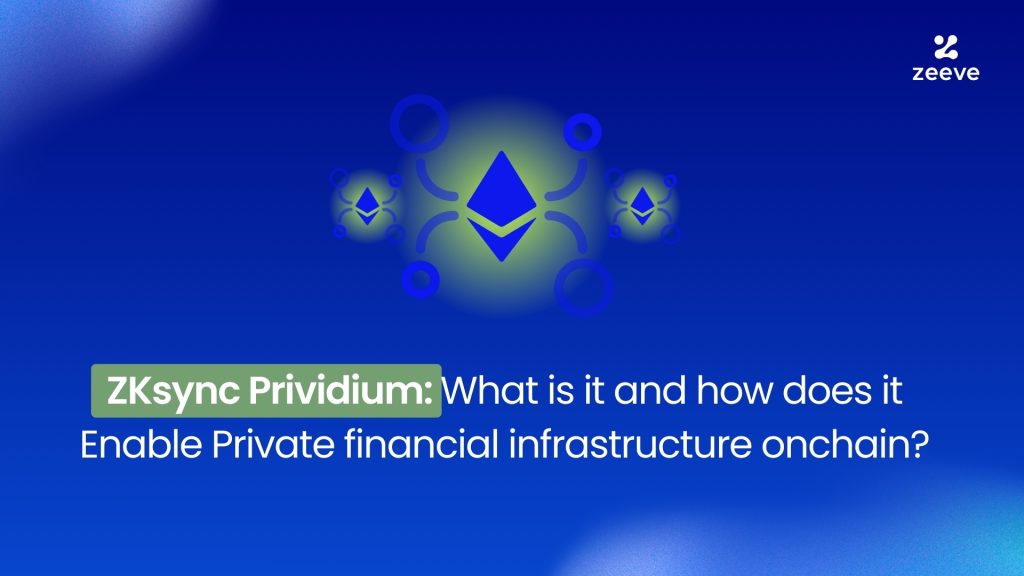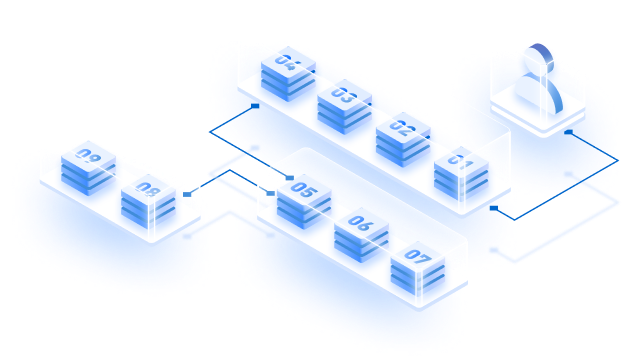Private financial institutions, despite the market cap of $2T are failing to modernize their financial structure because they have the compliance hurdle to cross. For example, Signature Bank’s Signet platform allowed trading in cryptos-fiat pairs for near instantaneous settlements but the platform was not in compliance as per SEC rules and regulations, forcing them to wrap up and shut operations in 2023.
Now on an average, to set-up such payment rails using a blockchain infra, there’s roughly $3M to $15 M in investments that these private institutions must undertake to build their infra. That said, no private financial institution would risk modernizing their systems unless they’re certain that they won’t be facing the same fate as Signature or Silicon Valley Bank due to inefficient blockchain infrastructure.
And that’s where the role of a robust, matured and battle-tested blockchain infra begins that can help them undertake smooth transition without risks involved.
ZKsync’s Prividium is going to do that, ensuring private institutions get that on their own terms. In this blog, we shall see how Prividium would make that happen for the private financial institutions, some other benefits, a case study of a live Prividium chain, and a lot more.
What is ZKsync Prividium
ZKsync Prividium, as an enterprise-ready blockchain solution, has been designed to help organizations meet mission critical needs of private finance like compliance, privacy, speed, security, and interoperability all occurring at once.
Due to this trade off, Prividium supports a wide range of financial use cases, from settlements and treasury management to asset tokenization.
But the interesting part every enterprise would love at first glance is allowing them to do all of that with existing infrastructure, without the need to rebuild systems from scratch.
But, with Prividum, this setup might mirror a rollup architecture which might bring some new vulnerabilities is something private financial institutions might think. And due to that, concern for institutions who might have tried a rollup before would be popping up in their head like MEV, front running. But such is not the case when you know how Prividum differs from rollups.
How does ZKsync Prividium Works?
There are a lot of checklists to acknowledge when you want a private institution app to have full control over their environment without the need to create an infrastructure from the ground up . And that’s where Zksync Prividium appeals to enterprises through an interface that might look like a public blockchain from a vantage point but look closer, and you find everything hybrid;
- Access Control Powered by YAML
- Private RPC Proxy through DMZ / API Gateway
- Private Subnet / Application Tier for verifiability , anonymity and camouflage.
- ZK Porters for proof submissions
Courtesy: ZKsync
The Benefits of ZKsync Prividium Chains:
Here are what private financial institutions will get from its design principles:
1. Complete Privacy and Control
Financial institutions have sensitive data with them like client identities, trade information, and even fund positions. When they are exposing the same to others using a public chain, it exposes multiple issues. For example, from the standpoint of a direct attack, it could be wallet compromise, ransom, fishing attacks and so on. And from an infrastructural drawback, a public chain can expose MEV risks. But since ZKsync Prividium would be giving a selective disclosure to the application, it can protect users from such exploits. ZKsync claims applications can have full control over the data and logic to ensure that privacy and control stay with institutions despite using public blockchains as mentioned in the tweet below;
Institutions moving onchain need speed, privacy, interoperability, and compliance.
— ZKsync (@zksync) July 3, 2025
Prividium — ZKsync’s enterprise-grade blockchain platform — is purpose-built to deliver.
Watch the vid to see how Prividium makes it possible. 👇🧵 pic.twitter.com/sq2rE2f4mw
2. Compliance Ready Chain
Private financial institutions refrain from allowing anyone to participate in their chain and meddle with their operations. Due to ZKsync Prividium’s on-chain identity traceability, enterprise applications hosted using Prividium can experience compliance by design but in the process, having full sovereignty to do things in the manner that would best to bake their own logic into the system. Due to this, despite using a public chain like Ethereum for security, banks, asset managers and other verticals can easily operate on top of the stack allowing them complete control.
3. Battle Tested Security
Security is paramount for the users and any instances of frauds or deceit should be easily auditable and traceable. Since with private blockchains, everything is highly siloed, it creates information/ accountability barriers. For anchoring the trust, private financial institutions need where they can verify and validate doubts but in the process, do not end up revealing data.
Through cryptographic proof generation that settles to Ethereum, the private financial institutions would be providing the security that users are seeking while using the financial application but at the same time, they can also protect chain snooping of sensitive data while doing the same. Alex Cardova, the CEO of Tradable lauds ZKsync for its robust security and Prividum using the ZK Stack inherits the same security levels.
"ZKsync is essentially table stakes for getting traditional financial institutions to adopt blockchain tech." — Alex Cordover, CEO of @TradableXYZ
— ZKsync (@zksync) March 21, 2025
After bringing $1.7B of tokenized private credit to @ZKsync, Alex explains why they chose us: security, privacy, and… pic.twitter.com/oYtDczdz6o
4. Interoperability by Design
At the moment, private financial institutions need to build bridges/ relayers with the partner networks when they are looking to interoperate. But in the process, they put security of the chain under risk. But with ZKsync Prividium, now private financial institutions can use the ZkSync chain architecture to set up smooth interoperability with the partner ecosystems making the stack suitable for those applications that are looking forward to launching multi-asset strategies and international operations.

The Target Use Cases Of Zksync Prividium Infrastructure:
1.Collateral Mobility:
At the moment, mobility of the collaterals are not expansive to accommodate borderless operations for TradFi. For context, the banks involved in the collateral exchange might face auditability and accountability loopholes because of different geographical locations, regulations and information blockade. But with Zksync Prividium, now banks/ financial institutions can easily exchange value despite being offshore in a real-time automated manner using smart-contracts. And while doing the same, they can even comply with regulatory checklists.
2.Wholesale Cross Border Payments:
At the moment, while undertaking cross border payments, banks have to settle for a check and balance mechanism, wherein, the receiver account will settle for the native fiat currency in exchange for foreign currency by verifying the source but different payment rails, time zone settlements create synchronicity among these systems. .With provable Zk-verified systems, now these lags could be mitigated for instant payment settlements, allowing traditional financial institutions to experience near instantaneous settlement and access global liquidity without any risk.
3. Global Payroll:
At the moment, if private financial institutions want to integrate a globalized system of payments for their enterprise clients, they face major roadblocks because employees might have to be paid in different currencies. In addition to that, there’s regulatory compliances to meet like tax laws, reporting and so forth. All of these make global payroll a headache for enterprises that they cannot cross due to lack of technological infrastructure. With ZKsync Prividium, this is getting resolved from the ground up.
4.Token Asset Issuance & Servicing:
At the moment, private financial institutions like banks, asset managers and even economies are issuing tokens against assets like government securities. But in the process, they create a barrier when regulation is involved. Moreover, network non synchrony creates real hassle to settle in real time. ZKsync Prividium allows role based controls and regulatory visibility without diluting the security to help make asset based issuance via tokens simple and fortified.

A Case Study of The First ZKsync Prividium Chain: Memento’s ZK Chain by Zeeve RaaS
Memento blockchain became the first real world experience to check the market readiness of ZKsync Prividium for launching Institutional DeFi Infrastructure for Project DAMA. Deutsche Bank wanted to modernize fund management in Singapore through project DAMA. But in pursuit of this, they faced pressing challenges like;
- High Cost
- Slow fund deployment
- Limited Liquidity
- Regulatory constraints.
Zksync Prividium chain allowed the Memento blockchain to validate funds coming from multiple sources that required permissions from multiple custodians, administrators, and intermediaries to launch Project DAMA. Due to this advantage, what could have otherwise taken months for Deutsche Bank was completed in a few days only with low fees, private-permissioned infrastructure and multichain readiness. But this transition wasn’t simple because multiple aspects were to be considered, improvised and delivered like logo bricks. For example;
- ZK Stack Deployment
- Private Explorers and RPCs
- ACL for Smart Contract Deployment
- ACL for Contract Interaction
- Custom L1→L2 Messaging ACL
For assembling all of these together, Zeeve played a pivotal role for the Memento blockchain to launch its first Institutional DeFi Infrastructure helping with : (i) Technical improvisations (ii) Security & governance (iii) Scalability & Future Readiness (iv) DevOps Automation (v) Enterprise Support (vi) Zero Trust Principles (vii) Custom L1→L2 Filtering Smart Contract.
Read the use cases here to know how the process was expedited to launch the chain in days and not months or years.
1/ Introducing ZKsync Prividium: an enterprise-grade blockchain platform for secure, compliant onchain finance.
— ZKsync (@zksync) May 27, 2025
Private. Permissioned. Anchored to Ethereum.
In use by @Memento_Bc: an institutional entry point to the Elastic Network designed for compliant asset origination. 🧵 pic.twitter.com/ZojLBi3tDt
Due to such a quick leap in such a short time, in May , Cointelegraph Magazine featured Memento ZK Chain alongside leading RWA and institutional infra players like Securitize, Tradeable, Ant Digital, and Ethena.
Build Your ZkSync Prividium Chain with Zeeve
Zeeve, as a trusted partner can help you launch a ZK rollup or ZKsync Prividium chain purpose built for your application. So far, Zeeve has been instrumental in helping some of the big names like Memento, Syscoin’s zkSYS, and many others to launch their ZK chains. If you want to build your own private financial application and you are looking for a Private financial infrastructure for moving your financial application onchain, Zeeve’s valuable integration partners, and fully managed ZKsync infrastructure-as-a-Service could provide the necessary support that you are seeking.
For further assistance to launch your custom ZKsync Prividum finance app or chain, our experts are just a click away to help you in all possible ways.




